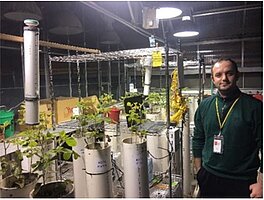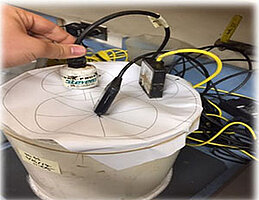Effect of different water table levels on soybean water use and growth parameters

Yavuz F Fidantemiz is a Master of Science student in Agricultural & Biosystems Engineering at North Dakota State University. He obtained his B.S. degree from Farm Structure and Irrigation Department at Ondokuz Mayis University, Turkey. His present research is focused on understanding the yield and seed quality performance of soybean under certain groundwater depths.
Email: yavuz.fidantemiz@ndsu.edu
Fellow: Yavuz F Fidantemiz
Advisor: Halis Simsek, Ph.D., Assistant Professor, Agricultural & Biosystems Engineering Department, North Dakota State University.
Degree Progress: M.S. at Agricultural & Biosystems Engineering Department, expected graduation in December 2018.
Effect of different water table levels on soybean water use and growth parameters
Understanding the water table contribution to plant water use is a significant element in improving water use efficiency for agricultural water management. This understanding could reduce either the drainage or irrigation water volume by enhancing the crop water uptake from accesible groundwater. Shallow groundwater is considered as an alternative water source for both dry and irrigated agriculture when the quality of groundwater is acceptable for sustainable crop production. Optimum water table depth not only supplies a significant amount of water to crops but it eliminates waterlogging in the root zone. Currently, most of the irrigation programs only use irrigation water to meet the plant water demand, and it is assumed that groundwater is deep enough so that capillary flux does not reach the root zone. Shallow groundwater can be considered as a water source which helps to decrease the need for irrigation water.
The surface irrigation method is used as a primary irrigation method even though the method has low water use efficiency (30-50%) and triggers waterlogging by raising the water table level. Water use efficiency can be increased by using modern irrigation systems with the optimum irrigation management that can control groundwater and eliminate waterlogging.
Soybean (Glycine max) is an oilseed crop commonly cultivated all around the world. The soybean’s seed contains about 40% protein and 20% oil, ranking highest for both among all other crops. Soybean as a legume is well acknowledged for its good agronomical performance as well as for its importance in sustainable agriculture systems. Soybean is a main oilseed crop in US and is a susceptible crop to water stress. North Dakota (ND) is one of the main states in the US where soybean is grown extensively. Statistics from ND Soybean Council indicate that ND is 4th in terms of acres planted in soybean in the US in 2014. Notably, five counties in ND were ranked the top 20 soybean producing counties in the US based on soybean yield (bushels/acres in 2014.
Due to many parameters affecting groundwater contributions of the plant growth, it is hard to determine this contribution in situ conditions (Ayars et al., 2006). Lysimeter studies are mostly used for determining water table contributions to plant water demands and effects of water table on crops growth (Ghamarnia and Daichin, 2013; Talebnejad and Sepaskhah, 2015). Controlled drainage is a type of water management that is used for water table control practices. It aims to increase crop yields and limit the nutrient losses from the root zone. Water table could be used to meet plant water requirements with controlled drainage applications. Currently, most of the irrigation programs only use irrigation water to determine plant water demand and ignore ground water contribution.
Project Objectives:
The main interest of this study was to answer the question of how much shallow groundwater could potentially be used for soybean production. Hence, the focuses of this study were to determine groundwater contributions to soybean water use and the soybean response to different water table levels. The specific objectives of the study is summarized as follows;
- To determine crop water of soybean from the different water table depths of 30, 50, 70, and 90 cm without irrigation condition.
- To determine the effects of shallow groundwater on soybean growth and yield parameters.
- To determine the effect of groundwater depth on root distribution of soybean.
Progress:
In the current study, the responses of soybean water uptake and crop growth to four constant water table depths (30, 50, 70, and 90 cm) were studied under a controlled environment using lysimeters. Additional to these lysimeters, one more set of lysimeters were used as a control treatment, and full irrigation without controlled water table was applied in these lysimeters. During the experiment, 50% of the available water was considered as a critical depletion point in the soil profile to apply the irrigation on the fully-irrigated lysimeters. The soybean growth parameters of plant height, nodes on main stem, and root parameters were measured. A randomized complete block design was used with six replications. The results indicated that the water table depths of 30, 50, 70 and 90 cm contributed to 77, 71, 65 and 62% of soybean water use, respectively. Thus, the water use efficiency, total grain yield (g lysimeter-1) per unit water use (cm), was found 0.08, 0.22, 0.18, 0.25, 0.31 at full irrigation (control treatment), 30, 50, 70, and 90 cm water table depth treatments, respectively. Soybean vegetative growth was found to be tolerant to shallow groundwater conditions.
Significance:
Establishing suitable conditions for plant root zone is important for both drainage and irrigation water management. Global oil demand is increasing and soybean, as a main oilseed crops in North Dakota, plays a key role to solve high oil demand. However, soybean is a sensitive crop to environmental stress. Water stress is an important problem that effect on soybean quantity and quality parameters.
Water content has a vital effect on both quality and quantity of soybean. Optimizing water utilization is crucial for growth of soybean. Because of environmental factors such as precipitation, solar radiation and evaporation on field conditions, detecting water demand for crops would not be accurate. Currently, most of the irrigation programs only use irrigation water to determine the plant water demand and ignore ground water contribution. Therefore, ground water contribution should be taking into consideration. Using lysimeter data could be a practical method to detect appropriate water demand for plants. Lysimeter devices in a controlled environment is the best ways to simulate field conditions. The data obtained in this study provide scientific contributions in the field of soil and water resources management, agricultural drainage and drainage systems planning.
Research Outcomes:
Yavuz F Fidantemiz, Xinhua Jia, Aaron L. Daigh, H. Hatterman-Valenti, Dean D. Steele, Ali R. Niaghi, Halis Simsek, 2018. Effect of different water table levels on soybean water use and growth parameters. Presented at ICSAE 2018 5th International Conference on Sustainable Agriculture and Environment, Oct. 8-10, Hammamet, Tunisia.


Halis Simsek
AES Ag & Biosystems Eng
Office: ABEN 2016
Phone: 701-231-6107
Email: halis.simsek@ndsu.edu


